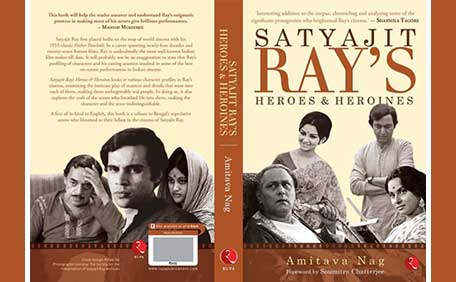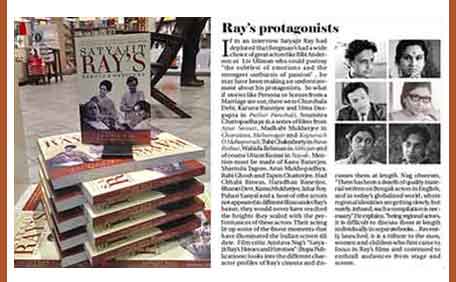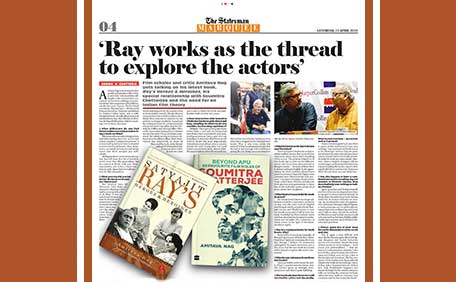Andhadhun: Suspense and Character Subjectivity
MK Raghavendra | Jan 26
 Fiction films of the world use three elements that combine to produce ‘cinema’ – objective reality, authorial subjectivity, which is in the nature of distortions to demarcate the real from the director’s subjective take on it, i.e.: the exercising of his or her powers of expression. Lastly, there is the notion of character subjectivity and this is the element needed to be used in abundance to create suspense. Suspense depends on knowledge of events being held by some and not by others…
Fiction films of the world use three elements that combine to produce ‘cinema’ – objective reality, authorial subjectivity, which is in the nature of distortions to demarcate the real from the director’s subjective take on it, i.e.: the exercising of his or her powers of expression. Lastly, there is the notion of character subjectivity and this is the element needed to be used in abundance to create suspense. Suspense depends on knowledge of events being held by some and not by others…
… Why Indian films are omniscient in perspective is not easy to explain but my view is that it lies in the notion of transcendental truths in which people have more faith than in the evidence of the senses, judged to be ephemeral; this is perhaps why most films have eternal messages to relate, usually from the epics or traditional wisdom.
Of Cinema and Women
Muktha | Jan 26
 In the context of cinema being a culture, we should look into the politics of filmmaking and biases in the field. Also, how cinema shapes society and how society further alters the evolution of films. The focus of this term paper is gender politics and how women’s ‘hands’ behind screen would make a difference to the medium and how this would give rise to an alter form. When world cinema completes more than a century from its origin, the role played by women off screen is extremely scarce. Women decorated roles as actresses and singers, but a significant position in the industry where her ‘voice’ is heard in cinema was left blank…
In the context of cinema being a culture, we should look into the politics of filmmaking and biases in the field. Also, how cinema shapes society and how society further alters the evolution of films. The focus of this term paper is gender politics and how women’s ‘hands’ behind screen would make a difference to the medium and how this would give rise to an alter form. When world cinema completes more than a century from its origin, the role played by women off screen is extremely scarce. Women decorated roles as actresses and singers, but a significant position in the industry where her ‘voice’ is heard in cinema was left blank…
… The influential French daily Le Monde once published an open letter. It read: “At Cannes, women show their breasts, men show their films.”
[spacer size=”20″]
Cinema in Uttar Pradesh
Gautam Kaul | Jan 26
 Few would know that once upon a time Lucknow also featured on the map of India as a centre of film production… It was Dilip Kumar who felt that Uttar Pradesh should have a film production centre and he applied for a piece of agricultural land in 1961, to develop a film studio… Uttar Pradesh is now threatening to provide more incentives of hassle free studio facilities and strike free environment to film production companies…
Few would know that once upon a time Lucknow also featured on the map of India as a centre of film production… It was Dilip Kumar who felt that Uttar Pradesh should have a film production centre and he applied for a piece of agricultural land in 1961, to develop a film studio… Uttar Pradesh is now threatening to provide more incentives of hassle free studio facilities and strike free environment to film production companies…
[divider size=”1″]
[spacer size=”20″]
Jyotiprasad Agarwala and his film Joymoti (1935): A moving tale of struggle and sacrifice
Parthajit Baruah | Jan 26
 The legacy Jyotiprasad Agarwala has left in Assam has been carried forward by Padum Barua, Dr. Bhabendra Nath Saikia, Jahnu Barua and a recent group of promising filmmakers such as Rima Das, Deep Choudhury, Reema Bora, Jaicheng Dohutia, Suraj Dowarah, Kangkan Deka, Khnajan Kishor Nath, and Nava Kumar Nath. But he who among others pioneered the growth of Indian cinema still remains ignored in the national narrative.
The legacy Jyotiprasad Agarwala has left in Assam has been carried forward by Padum Barua, Dr. Bhabendra Nath Saikia, Jahnu Barua and a recent group of promising filmmakers such as Rima Das, Deep Choudhury, Reema Bora, Jaicheng Dohutia, Suraj Dowarah, Kangkan Deka, Khnajan Kishor Nath, and Nava Kumar Nath. But he who among others pioneered the growth of Indian cinema still remains ignored in the national narrative.
[divider size=”1″]
[spacer size=”20″]
Cinematographic Consciousness
Devdutt Trivedi — | Jan 26
 The cinematograph provides us with a view of the world that is not a representation of the world outside, but is instead a space-time continuum representing an interiority that captures the internal state of the audience. This continuum is in the form of a sound-image block that provides us with a new understanding of reality. In other words, there is always a film playing beneath the surface, which is an indexical sign to the nature of reality that is both manifested and unmanifested…
The cinematograph provides us with a view of the world that is not a representation of the world outside, but is instead a space-time continuum representing an interiority that captures the internal state of the audience. This continuum is in the form of a sound-image block that provides us with a new understanding of reality. In other words, there is always a film playing beneath the surface, which is an indexical sign to the nature of reality that is both manifested and unmanifested…
[carousel_slider title=”Talks, literature, and screenings” images=”media: 1004,1145,1079,1148,1078,1077,1076,1080,1005,1006,1328,1085,1327″]
[j_accordion][j_acc_cat category_name=”Tributes” active=”1″][j_acc_row link_text=”Mrinal Sen: the master of cinema with a warm heart” link=”https://thewire.in/film/mrinal-sen-tribute” author_name=”Amit Khanna”][j_acc_row link_text=”Mrinal Sen… last giant from a key era in Indian cinema” link=”https://www.firstpost.com/entertainment/mrinal-sen-1923-2018-looking-back-at-the-filmography-of-the-last-giant-from-a-key-era-in-indian-cinema-5822041.html” author_name=”MK Raghavendra”][j_acc_row link_text=”Mrinal Sen: the man who fought through cinema” link=”https://learningandcreativity.com/silhouette/mrinal-sen/” author_name=”Ratnottama Sengupta”][j_acc_row link_text=”I loved Kader Khan. I spoke Kader Khan” link=”https://www.rediff.com/movies/column/saluting-kader-khan/20190107.htm” author_name=”Sukanya Verma”][/j_acc_cat][j_acc_cat category_name=”Book review” active=”0″][j_acc_row link_text=”Masala Shakespeare: how a firangi writer became Indian | Jonathan Gil Harris” link=”http://www.openthemagazine.com/article/books/shakespeare-and-company” author_name=”Jai Arjun Singh”][/j_acc_cat][j_acc_cat category_name=”Book excerpt” active=”0″][j_acc_row link_text=”Satyajit Ray said ‘Villains bore me’, but he had quite a few of them in his films” link=”https://scroll.in/reel/909556/satyajit-ray-said-villains-bore-me-but-he-had-quite-a-few-of-them-in-his-films” author_name=”Amitava Nag”][/j_acc_cat][j_acc_cat category_name=”Film reviews” active=”1″][j_acc_row link_text=”Bird of dusk | Sangeeta Datta” link=”https://www.freepressjournal.in/entertainment/bird-of-dusk-movie-review-cast-director/1445282″ author_name=”Johnson Thomas”][j_acc_row link_text=”Evening shadows | Sridhar Rangayan” link=”https://www.freepressjournal.in/entertainment/evening-shadows-movie-review-cast-director/1434952″ author_name=”Johnson Thomas”][j_acc_row link_text=”Glass | M. Night Shyamalan” link=”https://www.filmcompanion.in/glass-movie-review-samuel-l-jackson-bruce-willis-rahul-desai” author_name=”Rahul Desai”][j_acc_row link_text=”Kala bazar | Vijay Anand” link=”https://www.filmcompanion.in/bollywood-movies-50s-60s-dev-anand-waheeda-rehman/” author_name=”Jai Arjun Singh”][j_acc_row link_text=”Manikarnika: the queen of Jhansi | Krish & Kangana” link=”https://www.freepressjournal.in/entertainment/manikarnika-the-queen-of-jhansi-movie-review-cast-director/1445294″ author_name=”Johnson Thomas”][j_acc_row link_text=”Manikarnika: the queen of Jhansi |Krish & Kangana” link=”https://www.ndtv.com/entertainment/manikarnika-movie-review-kangana-ranauts-soulless-film-reduces-laxmi-bai-to-a-stunt-queen-1-star-out-1982958″ author_name=”Saibal Chatterjee”][j_acc_row link_text=”Manikarnika: the queen of Jhansi |Krish & Kangana” link=”https://www.rediff.com/movies/review/manikarnika-review-kangana-ranaut-is-savage-spellbinding/20190125.htm” author_name=”Sukanya Verma”][j_acc_row link_text=”Manikarnika: the queen of Jhansi |Krish & Kangana” link=”https://thewire.in/film/manikarnika-movie-review” author_name=”Tanul Thakur”][j_acc_row link_text=”Mayurakshi | Atanu Ghosh” link=”https://learningandcreativity.com/silhouette/mayurakshi-review/” author_name=”Amitava Nag”][j_acc_row link_text=”Mem didi | Hrishikesh Mukherjee” link=”https://www.filmcompanion.in/bollywood-movies-50s-60s-hrishikesh-mukherjee-mem-didi/” author_name=”Jai Arjun Singh”][j_acc_row link_text=”Rubaru Roshni | Svati Chakravarty Bhatkal” link=”https://www.freepressjournal.in/entertainment/rubaru-roshni-movie-review-cast-director/1445278″ author_name=”Johnson Thomas”][j_acc_row link_text=”Soni | Ivan Ayr” link=”https://www.telegraphindia.com/entertainment/times-up-for-simmba-dabangg-soni-is-the-new-angry-cop/cid/1682654″ author_name=”Jai Arjun Singh”][j_acc_row link_text=”Soni | Ivan Ayr” link=”https://www.filmcompanion.in/soni-geetika-vidya-ohlyan-saloni-batra-rahul-desai” author_name=”Rahul Desai”][j_acc_row link_text=”Soni | Ivan Ayr” link=”https://www.ndtv.com/entertainment/soni-movie-review-saloni-batras-slow-burning-drama-grabs-you-from-scene-one-4-5-stars-out-of-5-1979851?fbclid=IwAR312fy-9kFJzaNZ07vJ46ifB0V9QigVdSg4XthYVdDRxxEiPAzgGQFkW5Y” author_name=”Saibal Chatterjee”][j_acc_row link_text=”Thackeray | Abhijit Panse” link=”https://www.filmcompanion.in/thackeray-movie-review-nawazuddin-siddiqui-baradwaj-rangan” author_name=”Baradwaj Rangan”][j_acc_row link_text=”Thackeray | Abhijit Panse” link=”https://www.freepressjournal.in/entertainment/thackeray-movie-review-cast-director/1445290″ author_name=”Johnson Thomas”][j_acc_row link_text=”Thackeray | Abhijit Panse” link=”https://www.ndtv.com/entertainment/thackeray-movie-review-nawazuddin-siddiqui-is-outstanding-performer-in-a-film-best-left-alone-1-5-st-1983215″ author_name=”Saibal Chatterjee”][j_acc_row link_text=”The lift boy | Jonathan Augustine” link=”https://www.freepressjournal.in/entertainment/the-lift-boy-movie-review-cast-director/1440000″ author_name=”Johnson Thomas”][j_acc_row link_text=”Uri: the surgical strike | Aditya Dhar” link=”https://baradwajrangan.wordpress.com/2019/01/17/uri-the-surgical-strike-not-so-much-a-war-movie-as-a-hukumat-style-revenge-drama-but-it-works/?fbclid=IwAR1goVs5fOZGdAKydRqupKI_IGQxCmp24DDDMRnb5B6DRVbhlpVRugL9ipE” author_name=”Baradwaj Rangan”][j_acc_row link_text=”Uri: the surgical Strike | Aditya Dhar” link=”https://www.freepressjournal.in/entertainment/uri-the-surgical-strike-movie-review-cast-director/1434944″ author_name=”Johnson Thomas”][j_acc_row link_text=”Uri: the surgical strike | Aditya Dhar” link=”https://www.ndtv.com/entertainment/uri-the-surgical-strike-movie-review-without-vicky-kaushal-it-would-be-a-complete-washout-2-stars-ou-1976284″ author_name=”Saibal Chatterjee”][/j_acc_cat][j_acc_cat category_name=”Interview” active=”0″][j_acc_row link_text=”Soumitra Chatterjee on working with Satyajit Ray: ‘Our wavelengths matched’” link=”https://scroll.in/reel/827001/soumitra-chatterjee-on-working-with-satyajit-ray-our-wavelengths-matched” author_name=”Amitava Nag”][/j_acc_cat][j_acc_cat category_name=”Features” active=”1″][j_acc_row link_text=”Why the Sivaji Ganesan kind of stardom isn’t possible anymore” link=”https://www.filmcompanion.in/baradwaj-rangan-column-southern-lights-why-the-sivaji-ganesan-kind-of-stardom-isnt-possible-anymore/” author_name=”Baradwaj Rangan”][j_acc_row link_text=”Today, women don’t fall for unsuitable men” link=”https://www.freepressjournal.in/analysis/today-women-dont-fall-for-unsuitable-men/1426912″ author_name=”Deepa Gahlot”][j_acc_row link_text=”Marathi movies: a confident beginning” link=”https://punemirror.indiatimes.com/entertainment/marathi-reviews/marathi-movies-a-confident-beginning/articleshow/67327488.cms?” author_name=”Ganesh Matkari”][j_acc_row link_text=”Othello and Hamlet figure in Assamese narratives” link=”https://cinematicillusions.com/features/othello-and-hamlet-figure-in-assamese-narratives/” author_name=”Parthajit Baruah”][/j_acc_cat][j_acc_cat category_name=”Film essays” active=”0″][j_acc_row link_text=”Notes on Vertigo, La Jetee, and Uski Roti” link=”https://devduttblog.wordpress.com/2019/01/08/notes-on-vertigo-la-jetee-and-uski-roti/” author_name=”Devdutt Trivedi”][/j_acc_cat][/j_accordion]
[athird_col title=”ON OLD FILM ARTICLES” info=”Jai Arjun Singh, Yasser Usman, and Rakshanda Jalilin in a discussion around Yasir Abbasi’s book of translations of old film pieces from Urdu magazines.”][youtube_advanced url=”https://www.youtube.com/watch?v=W29uwHLbiWc” width=”280″ height=”200″ responsive=”no”][/athird_col][athird_col title=”ON CINEMA” info=”Baradwaj Rangan, on TEDx IIM Shillong, talks about cinema and lateral thinking /interpretation, and reveals the art of finding meaning in every single shot.”][youtube_advanced url=”https://www.youtube.com/watch?v=eLbzuLPOhgk” width=”280″ height=”200″ responsive=”no”][/athird_col][athird_col title=”ON A CHILDREN’S FILM” info=”Utpal Borpujari’s National Award winning ‘Ishu’ picks up the Sailadhar Baruah Award for Best Film, and closes the Guwahati International Children’s Film Festival.”][youtube_advanced url=”https://www.youtube.com/watch?v=_mf7gLpg9qc” width=”280″ height=”200″ responsive=”no” autoplay=”yes”][/athird_col]
BOOK LAUNCH
Satyajit Ray’s Heroes and Heroines | Amitava NagThe Statesman | Millennium Post | Tribune | The Wire | Get Bengal | The Citizen | The Free Press Journal | The New Indian Express | Asian Age | India Today | Youtube | Amazon
Biannual Issue
[j_list][j_item info1=”Vol. 1. Iss. 1″ info2=”January” url=”https://filmcriticscircle.com/journal/vol-1-iss-1/”][j_item info1=”Vol. 1. Iss. 2″ info2=”February” url=”https://filmcriticscircle.com/journal/vol-1-iss-2/” img=””][j_item info1=”Vol. 1. Iss. 3″ info2=”March” url=”https://filmcriticscircle.com/journal/vol-1-iss-3/”]
[j_item info1=”Vol. 1. Iss. 4″ info2=”April” url=”https://filmcriticscircle.com/journal/vol-1-iss-4/”][j_item info1=”Vol. 1. Iss. 5″ info2=”May” url=”https://filmcriticscircle.com/journal/vol-1-iss-5/”][j_item info1=”Vol. 1. Iss. 6″ info2=”June” url=”https://filmcriticscircle.com/journal/vol-1-iss-6/”][/j_list]






Good Job guys. Hope this journal becomes a platform of diverse views on cinema. Sharing a perspective with your peers and the coming generation is always a rewarding experience .The art form of film needs to redefine its boundaries even as it discovers the still hidden layers of its complexity
Here’s wishing to more stimulating writing and debate in this journal. Best
Amit Khanna
Is it a printed magazine?
Perhaps some time in the long run, KJ Thomas. Thanks for the query. Presently, the focus is purely online.